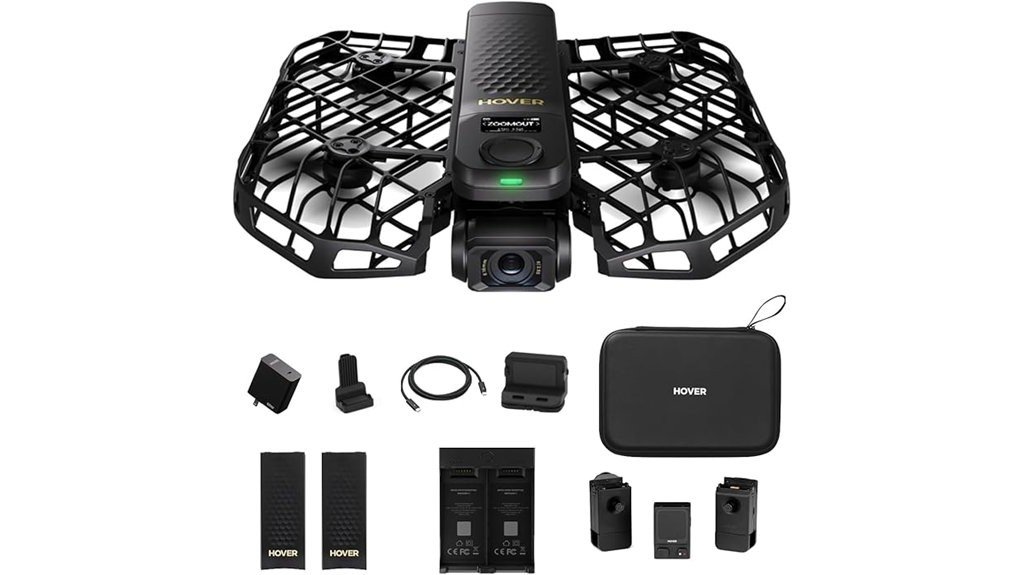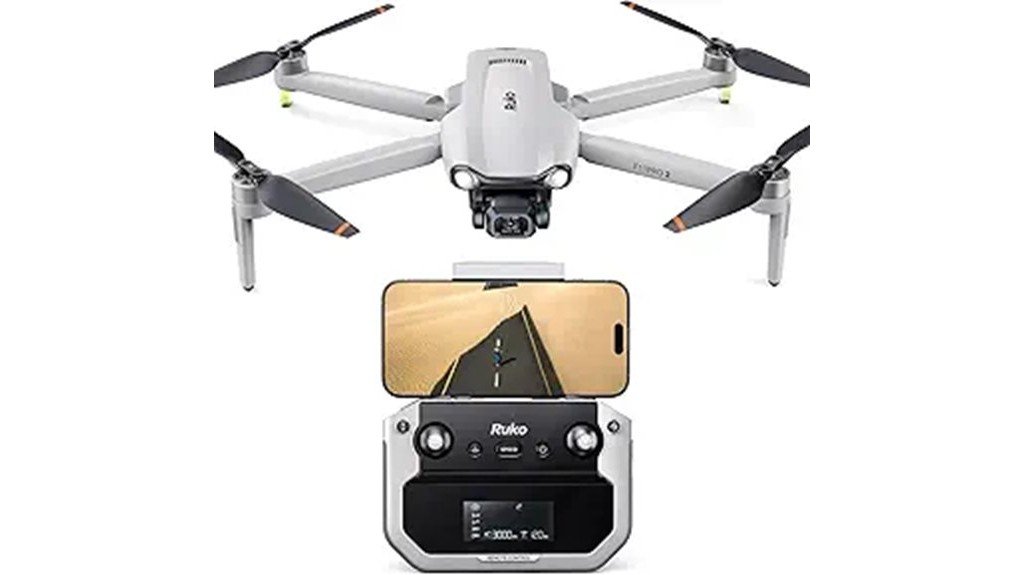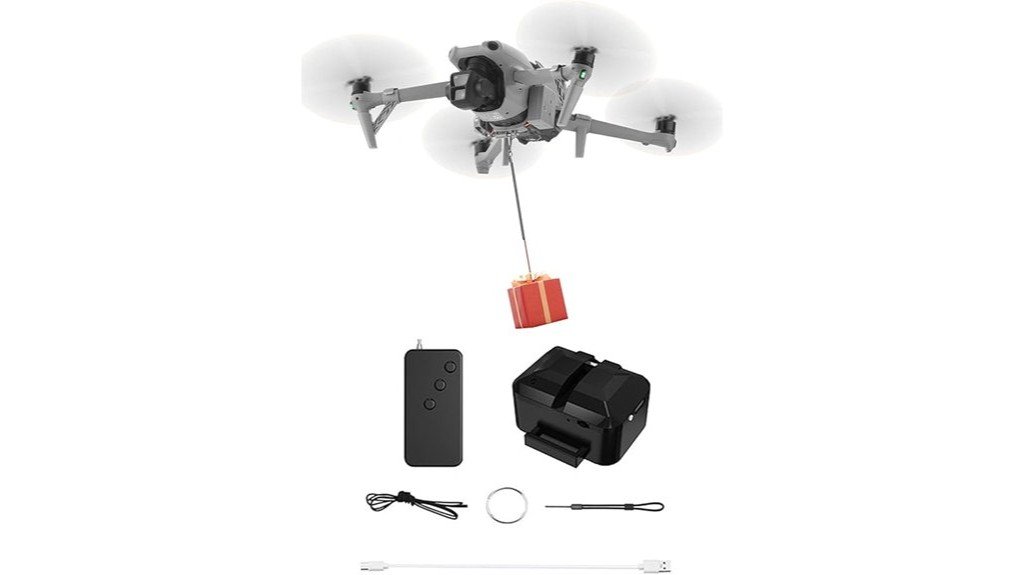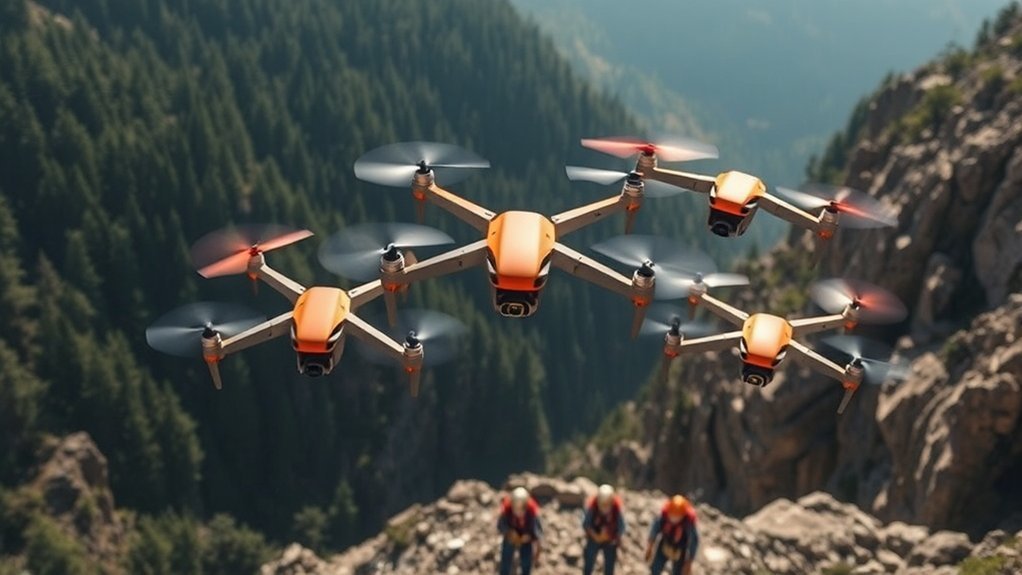Imagine a rescue team using the X1 PROMAX 8K drone to locate a missing hiker in rugged terrain. This powerful tool captures stunning 8K footage, aiding in quick assessments. As you explore the top drones for search and rescue in 2025, you’ll discover how advancements in technology can enhance operational efficiency and improve outcomes. What features should you prioritize to guarantee peak performance during critical missions?
X1 PROMAX 8K Action Flying Camera Drone

The X1 PROMAX 8K Action Flying Camera Drone is an exceptional choice for search and rescue missions, especially if you need high-quality visual data from challenging environments. With its groundbreaking 8K@30fps video capabilities, you’ll capture stunning footage that enhances situational awareness. The innovative OmniTerrain feature allows you to fly over snow, water, and cliffs effortlessly. You’ll benefit from over 10 automatic flight modes, including Follow and Zoom Out, tailored for diverse scenarios. Plus, its compact, foldable design makes it easy to transport. This drone’s advanced technology guarantees safer tracking, making it an invaluable tool for your missions.
Best For: Adventurers and content creators seeking high-quality aerial footage in challenging environments.
Pros:
- Exceptional 8K@30fps video quality enhances visual data for various applications.
- OmniTerrain feature allows for versatile flying over diverse landscapes like snow and water.
- Compact, foldable design ensures easy transport and storage.
Cons:
- Battery life is relatively short, ranging from 10-13 minutes.
- Potential loss of tracking in complex environments may affect performance.
- Some users have reported video stabilization issues under certain conditions.
Ruko F11PRO 2 Drone with 6K Camera

For those involved in search and rescue missions, the Ruko F11PRO 2 Drone with its impressive 6K camera stands out as a powerful tool. You’ll capture stunning 6K photos and 4K video, thanks to its advanced sensor that guarantees clarity and vibrant colors. The 3-axis brushless gimbal provides exceptional stability, even in windy conditions. With two batteries offering a total of 70 minutes of flight time, you can cover more ground. Intelligent flight modes like follow-me and waypoint planning make it easy to operate, allowing you to focus on the mission at hand while capturing critical footage seamlessly.
Best For: The Ruko F11PRO 2 Drone is best for search and rescue teams needing reliable aerial footage with high-definition clarity.
Pros:
- 6K photo and 4K video capabilities provide exceptional image quality for critical documentation.
- 3-axis brushless gimbal ensures smooth and stable footage even in challenging weather conditions.
- Intelligent flight modes simplify operation, making it user-friendly for both beginners and professionals.
Cons:
- Optimal performance requires the use of the Ruko charger, limiting charging options.
- Flight time may be affected by environmental factors, such as wind or temperature.
- Higher initial investment compared to entry-level drones may be a barrier for some users.
Drone Payload Release Airdrop System for DJI Drones

Seeking an efficient way to deliver essential supplies during search and rescue missions? The Drone Payload Release Airdrop System for DJI drones, compatible with models like the Mini 4 Pro and Mavic 3, makes it easy. With a payload capacity of up to 1000g, this lightweight system allows you to drop items remotely using one-button operation. Installation is straightforward and won’t damage your drone. Plus, it features USB charging and a quick release mechanism. Rated 4.5 stars, it’s perfect for delivering crucial supplies, gifts, or meals, ensuring you can reach those in need quickly and effectively.
Best For: The Drone Payload Release Airdrop System is best for individuals and organizations involved in search and rescue operations, event planning, or outdoor activities like fishing.
Pros:
- Lightweight design (only 42g) minimizes impact on drone performance.
- One-button operation allows for easy remote dispatch of items.
- Versatile applications suitable for delivering supplies, gifts, and meals.
Cons:
- Limited payload capacity (100g for Mini 4 Pro/Mini 3 Pro/F11) may restrict larger deliveries.
- Remote control range of only 500m may limit operational distance.
- Installation precautions required to avoid blocking drone sensors.
Factors to Consider When Choosing a Drone for Search and Rescue
When choosing a drone for search and rescue missions, you need to take into account several key factors. Think about payload capacity, flight time, and camera quality to guarantee you meet mission requirements. Also, evaluate navigation features and durability to handle various weather conditions effectively.
Payload Capacity Requirements
Payload capacity is a critical factor in choosing a drone for search and rescue missions, as it directly affects the drone’s ability to transport essential supplies. Ideally, you should look for drones that support a minimum payload of 1000g to effectively carry life-saving items like medical supplies or food. Keep in mind that different models have varying maximum load limits; lighter drones may only manage around 100g, which isn’t sufficient for most rescue scenarios. Additionally, the capability to carry specialized equipment like thermal cameras or emergency beacons often requires higher payload capacities. Always consider the drone’s overall weight and structure to ascertain that the added payload won’t compromise its flight stability and maneuverability during critical missions.
Flight Time Considerations
Flight time is vital for effective search and rescue missions, as it determines how far and wide you can search without needing to recharge or swap batteries. Longer flight times, like the Ruko F11PRO 2’s impressive 70 minutes with dual batteries, enable more extensive coverage, which is essential in emergencies. In contrast, drones with only 10 to 13 minutes of flight time can limit your operational efficiency, forcing you to plan carefully. Remember, carrying additional payloads, such as airdrop systems, can greatly reduce flight time, so choose a drone that balances capacity with extended duration. Finally, keep environmental factors in mind—wind and temperature can affect performance, so opt for drones designed with stability and wind resistance features for reliable missions.
Camera Quality Importance
While choosing a drone for search and rescue missions, camera quality plays a pivotal role in your success. High-resolution cameras capable of 6K or 8K video capture provide clarity vital for identifying individuals or objects. Advanced features like night mode enhance visibility in low-light conditions, allowing effective operations after dark. Opt for drones with a wide field of view; this increases your chances of spotting missing persons or important items in one frame. Additionally, electronic image stabilization technology reduces motion blur, ensuring that your footage remains steady during dynamic flight conditions. High-quality images and videos are essential for later analysis and documentation, aiding in strategy and coordination efforts for successful missions. Choose wisely to maximize your drone’s effectiveness.
Navigation and Control Features
How can effective navigation and control features enhance your search and rescue operations? Look for drones with intelligent flight capabilities like waypoint planning and follow-me modes to streamline your navigation. GPS stability is essential, guaranteeing precise control and positioning while covering large areas efficiently. Advanced collision detection systems can help you avoid obstacles in complex environments, enhancing safety during missions. Additionally, consider drones that allow remote control from at least 500 meters away, giving you greater operational flexibility. Finally, don’t overlook the importance of a reliable power source and extended flight times, as prolonged operations are often required in search and rescue scenarios. These features collectively guarantee your drone performs at its best when it matters most.
Durability and Weather Resistance
When you’re on a search and rescue mission, choosing a drone that’s both durable and weather-resistant can make all the difference. You need a drone that can withstand harsh conditions like rain, snow, and strong winds without losing functionality. Look for models made from lightweight aerospace-grade materials, guaranteeing superior structural integrity and resilience during rough handling. Weather resistance features, like waterproofing and temperature tolerance, are essential for reliable performance in unpredictable environments. Additionally, the drone’s design should protect against impacts and abrasions common in rugged terrains. Enhanced flight stability through advanced gimbal systems and wind resistance capabilities also guarantees effective operation in challenging weather, allowing you to capture clear imagery for critical assessments.
Ease of Use
Choosing the right drone for search and rescue missions hinges on ease of use, and several key factors can enhance your operational efficiency. Look for drones with hands-free operation features like voice command takeoff, simplifying launches in critical situations. Opt for models with intuitive app controls, enabling easy configuration of flight modes without extensive training. Automated flight modes, such as follow-me or waypoint planning, can markedly boost efficiency for beginners. Evaluate stability features like a 3-axis gimbal to maintain steady footage even in tough conditions, ensuring you capture usable data. Finally, prioritize drones with positive user feedback regarding ease of use, as this indicates a more user-friendly experience under pressure, making your mission smoother.

